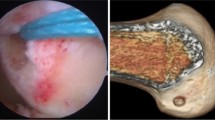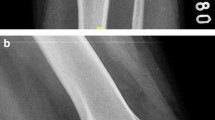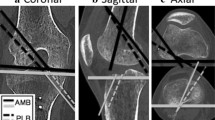Abstract
Purpose
This study was conducted to compare the efficacy between the oval femoral tunnel technique and the conventional round femoral tunnel technique in ACL reconstruction using an autologous hamstring tendon on the basis of the postoperative clinical outcomes and ACL graft tendon maturity. The hypothesis was that ACL reconstruction performed using the oval femoral tunnel technique was better than that performed using the round femoral tunnel technique in clinical functions and graft maturity.
Methods
One hundred and eight patients who underwent anatomical single-bundle ACL reconstruction were included in this study and the follow-up period was at least 2 years. Thirty-nine patients admitted between February and August in 2016 were included in the oval femoral tunnel group and 69 patients admitted between September 2016 and March 2017 were included in the round femoral tunnel group. The Lachman test result, pivot-shift test result, Lysholm score, IKDC score, and VAS score were used for the clinical evaluation. An objective assessment of anteroposterior stability was performed using a KT1000 arthrometer. Postoperative MRI was conducted to compare the ACL graft maturity differences between the oval femoral tunnel group and round femoral tunnel group, where the signal/noise quotient (SNQ) was calculated. In addition, second-look arthroscopy was conducted to compare the graft status and synovial coverage at 24 months postoperatively.
Results
All the patients presented with significant improvement in all clinical scores from the preoperative period to the 24-month follow-up. During the postoperative follow-up period, no statistically significant differences were found between the two groups in terms of the VAS score, knee ROM, Lachman test results, and graft status determined in the second-look arthroscopic evaluation. The Lysholm score was 97.1 ± 3.9 and 94.8 ± 5.6 in the oval femoral tunnel group and round femoral tunnel group, respectively, at the 24-month follow-up (p = 0.031). The IKDC subjective score was 92.0 ± 2.6 and 89.0 ± 3.6 in the oval femoral tunnel group and round femoral tunnel group, respectively, at the end of the follow-up period (p < 0.001). Significantly more patients with 1-degree positive pivot-shift test results were observed in the round femoral tunnel group (10/65) than in the oval femoral tunnel group (1/37) at the end of the follow-up period (p = 0.048). The mean SNQ of the oval femoral tunnel group was 2.7 ± 0.9, which was significantly lower than that of the round femoral tunnel group (3.6 ± 1.1) at the 24-month postoperative follow-up (p < 0.001).
Conclusions
Based on the clinical evaluations, MRI findings and second-look arthroscopy results of the two groups, the oval femoral tunnel technique yielded significantly better knee function and knee laxity restoration and more mature ACL grafts than the round femoral tunnel technique, whereas no significant differences were found at the second-look arthroscopy.
Level of evidence
III.



Similar content being viewed by others
References
Aga C, Kartus JT, Lind M, Lygre SHL, Granan LP, Engebretsen L (2017) Risk of revision was not reduced by a double-bundle acl reconstruction technique: results from the scandinavian registers. Clin Orthop Relat Res 475:2503–2512
Ahn JH, Kim JD, Kang HW (2015) Anatomic placement of the femoral tunnels in double-bundle anterior cruciate ligament reconstruction correlates with improved graft maturation and clinical outcomes. Arthroscopy 31:2152–2161
Bjornsson H, Andernord D, Desai N, Norrby O, Forssblad M, Petzold M et al (2015) No difference in revision rates between single- and double-bundle anterior cruciate ligament reconstruction: a comparative study of 16,791 patients from the Swedish national knee ligament register. Arthroscopy 31:659–664
Branch TP, Mayr HO, Browne JE, Campbell JC, Stoehr A, Jacobs CA (2010) Instrumented examination of anterior cruciate ligament injuries: minimizing flaws of the manual clinical examination. Arthroscopy 26:997–1004
Chen H, Chen B, Tie K, Fu Z, Chen L (2018) Single-bundle versus double-bundle autologous anterior cruciate ligament reconstruction: a meta-analysis of randomized controlled trials at 5-year minimum follow-up. J Orthop Surg Res 13:50
Collins NJ, Misra D, Felson DT, Crossley KM, Roos EM (2011) Measures of knee function: International Knee Documentation Committee (IKDC) Subjective Knee Evaluation Form, Knee Injury and Osteoarthritis Outcome Score (KOOS), Knee Injury and Osteoarthritis Outcome Score Physical Function Short Form (KOOS-PS), Knee Outcome Survey Activities of Daily Living Scale (KOS-ADL), Lysholm Knee Scoring Scale, Oxford Knee Score (OKS), Western Ontario and McMaster Universities Osteoarthritis Index (WOMAC), Activity Rating Scale (ARS), and Tegner Activity Score (TAS). Arthritis Care Res (Hoboken) 63(Suppl 11):S208–S228
Dhawan A, Gallo RA, Lynch SA (2016) Anatomic tunnel placement in anterior cruciate ligament reconstruction. J Am Acad Orthop Surg 24:443–454
Fu FH, van Eck CF, Tashman S, Irrgang JJ, Moreland MS (2015) Anatomic anterior cruciate ligament reconstruction: a changing paradigm. Knee Surg Sports Traumatol Arthrosc 23:640–648
Grevnerts HT, Terwee CB, Kvist J (2015) The measurement properties of the IKDC-subjective knee form. Knee Surg Sports Traumatol Arthrosc 23:3698–3706
Hofbauer M, Muller B, Murawski CD, van Eck CF, Fu FH (2014) The concept of individualized anatomic anterior cruciate ligament (ACL) reconstruction. Knee Surg Sports Traumatol Arthrosc 22:979–986
Irarrazaval S, Albers M, Chao T, Fu FH (2017) Gross, Arthroscopic, and radiographic anatomies of the anterior cruciate ligament: foundations for anterior cruciate ligament surgery. Clin Sports Med 36:9–23
Kaeding CC, Leger-St-Jean B, Magnussen RA (2017) Epidemiology and diagnosis of anterior cruciate ligament injuries. Clin Sports Med 36:1–8
Komzak M, Hart R, Feranec M, Smid P, Kocova R (2018) In vivo knee rotational stability 2 years after double-bundle and anatomic single-bundle ACL reconstruction. Eur J Trauma Emerg Surg 44:105–111
Kondo E, Yasuda K (2007) Second-look arthroscopic evaluations of anatomic double-bundle anterior cruciate ligament reconstruction: relation with postoperative knee stability. Arthroscopy 23:1198–1209
Kraeutler MJ, Wolsky RM, Vidal AF, Bravman JT (2017) Anatomy and biomechanics of the native and reconstructed anterior cruciate ligament: surgical implications. J Bone Joint Surg Am 99:438–445
Lopes OV Jr, de Freitas SL, Leite LHC, Buzzeto BQ, Saggin PRF, Kuhn A (2017) Femoral tunnel enlargement after anterior cruciate ligament reconstruction using RigidFix compared with extracortical fixation. Knee Surg Sports Traumatol Arthrosc 25:1591–1597
Lu W, Zhu W, Peng L, Fen W, Li H, Ou Y et al (2015) Femoral footprint variation of the posterolateral bundle of the anterior cruciate ligament and double-bundle reconstruction. Knee 22:169–173
Ma Y, Murawski CD, Rahnemai-Azar AA, Maldjian C, Lynch AD, Fu FH (2015) Graft maturity of the reconstructed anterior cruciate ligament 6 months postoperatively: a magnetic resonance imaging evaluation of quadriceps tendon with bone block and hamstring tendon autografts. Knee Surg Sports Traumatol Arthrosc 23:661–668
Mayr HO, Benecke P, Hoell A, Schmitt-Sody M, Bernstein A, Suedkamp NP et al (2016) Single-bundle versus double-bundle anterior cruciate ligament reconstruction: a comparative 2-year follow-up. Arthroscopy 32:34–42
McLean SG, Mallett KF, Arruda EM (2015) Deconstructing the anterior cruciate ligament: what we know and do not know about function, material properties, and injury mechanics. J Biomech Eng 137:020906
Mermerkaya MU, Atay OA, Kaymaz B, Bekmez S, Karaaslan F, Doral MN (2015) Anterior cruciate ligament reconstruction using a hamstring graft: a retrospective comparison of tunnel widening upon use of two different femoral fixation methods. Knee Surg Sports Traumatol Arthrosc 23:2283–2291
Mochizuki T, Fujishiro H, Nimura A, Mahakkanukrauh P, Yasuda K, Muneta T et al (2014) Anatomic and histologic analysis of the mid-substance and fan-like extension fibres of the anterior cruciate ligament during knee motion, with special reference to the femoral attachment. Knee Surg Sports Traumatol Arthrosc 22:336–344
Nakase J, Toratani T, Kosaka M, Ohashi Y, Numata H, Oshima T et al (2016) Technique of anatomical single bundle ACL reconstruction with rounded rectangle femoral dilator. Knee 23:91–96
Noh JH, Yang BG, Roh YH, Kim SW, Kim W (2011) Anterior cruciate ligament reconstruction using 4-strand hamstring autograft: conventional single-bundle technique versus oval-footprint technique. Arthroscopy 27:1502–1510
Oshima T, Nakase J, Numata H, Takata Y, Tsuchiya H (2016) The cross-sectional shape of the fourfold semitendinosus tendon is oval, not round. J Exp Orthop 3:28
Petersen W, Forkel P, Achtnich A, Metzlaff S, Zantop T (2013) Technique of anatomical footprint reconstruction of the ACL with oval tunnels and medial portal aimers. Arch Orthop Trauma Surg 133:827–833
Petersen W, Zantop T (2007) Anatomy of the anterior cruciate ligament with regard to its two bundles. Clin Orthop Relat Res 454:35–47
Pugh L, Mascarenhas R, Arneja S, Chin PY, Leith JM (2009) Current concepts in instrumented knee-laxity testing. Am J Sports Med 37:199–210
Sasaki N, Ishibashi Y, Tsuda E, Yamamoto Y, Maeda S, Mizukami H et al (2012) The femoral insertion of the anterior cruciate ligament: discrepancy between macroscopic and histological observations. Arthroscopy 28:1135–1146
Schillhammer CK, Reid JB 3rd, Rister J, Jani SS, Marvil SC, Chen AW et al (2016) Arthroscopy up to date: anterior cruciate ligament anatomy. Arthroscopy 32:209–212
Sepulveda F, Sanchez L, Amy E, Micheo W (2017) Anterior cruciate ligament injury: return to play, function and long-term considerations. Curr Sports Med Rep 16:172–178
Shimizu R, Adachi N, Ishifuro M, Nakamae A, Ishikawa M, Deie M et al (2017) Bone tunnel change develops within two weeks of double-bundle anterior cruciate ligament reconstruction using hamstring autograft: a comparison of different postoperative immobilization periods using computed tomography. Knee 24:1055–1066
Siebold R, Schuhmacher P, Fernandez F, Smigielski R, Fink C, Brehmer A et al (2015) Flat midsubstance of the anterior cruciate ligament with tibial "C"-shaped insertion site. Knee Surg Sports Traumatol Arthrosc 23:3136–3142
Slattery C, Kweon CY (2018) Classifications in brief: outerbridge classification of chondral lesions. Clin Orthop Relat Res 476:2101–2104
Smigielski R, Zdanowicz U, Drwiega M, Ciszek B, Ciszkowska-Lyson B, Siebold R (2015) Ribbon like appearance of the midsubstance fibres of the anterior cruciate ligament close to its femoral insertion site: a cadaveric study including 111 knees. Knee Surg Sports Traumatol Arthrosc 23:3143–3150
Smigielski R, Zdanowicz U, Drwiega M, Ciszek B, Williams A (2016) The anatomy of the anterior cruciate ligament and its relevance to the technique of reconstruction. Bone Joint J 98-b:1020–1026
Tanaka Y, Yonetani Y, Shiozaki Y, Kanamoto T, Kita K, Amano H et al (2014) MRI analysis of single-, double-, and triple-bundle anterior cruciate ligament grafts. Knee Surg Sports Traumatol Arthrosc 22:1541–1548
Tegner Y, Lysholm J (1985) Rating systems in the evaluation of knee ligament injuries. Clin Orthop Relat Res 198:43–49
van Meer BL, Meuffels DE, Vissers MM, Bierma-Zeinstra SM, Verhaar JA, Terwee CB et al (2013) Knee injury and Osteoarthritis Outcome Score or International Knee Documentation Committee Subjective Knee Form: which questionnaire is most useful to monitor patients with an anterior cruciate ligament rupture in the short term? Arthroscopy 29:701–715
Wang W, Liu L, Chang X, Jia ZY, Zhao JZ, Xu WD (2016) Cross-cultural translation of the Lysholm knee score in Chinese and its validation in patients with anterior cruciate ligament injury. BMC Musculoskelet Disord 17:436
Funding
None.
Author information
Authors and Affiliations
Corresponding author
Ethics declarations
Conflict of interest
On behalf of all the authors, the corresponding author states that there is no conflict of interest.
Ethical approval
Ethical approval was obtained from the Institutional Review Board (IRB) of the First Affiliated Hospital of Chongqing Medical University (ID 2016-178).
Informed consent
In this prospective non-randomized controlled study, informed consent was obtained from all the patients regarding the details of the study and all possible complications related to the study.
Additional information
Publisher's Note
Springer Nature remains neutral with regard to jurisdictional claims in published maps and institutional affiliations.
Electronic supplementary material
Below is the link to the electronic supplementary material.
Supplementary file1 (MP4 18911 kb)
Supplementary file2 (MP4 14711 kb)
Rights and permissions
About this article
Cite this article
Wen, Z., Zhang, H., Yan, W. et al. Oval femoral tunnel technique is superior to the conventional round femoral tunnel technique using the hamstring tendon in anatomical anterior cruciate ligament reconstruction. Knee Surg Sports Traumatol Arthrosc 28, 2245–2254 (2020). https://doi.org/10.1007/s00167-019-05809-4
Received:
Accepted:
Published:
Issue Date:
DOI: https://doi.org/10.1007/s00167-019-05809-4




